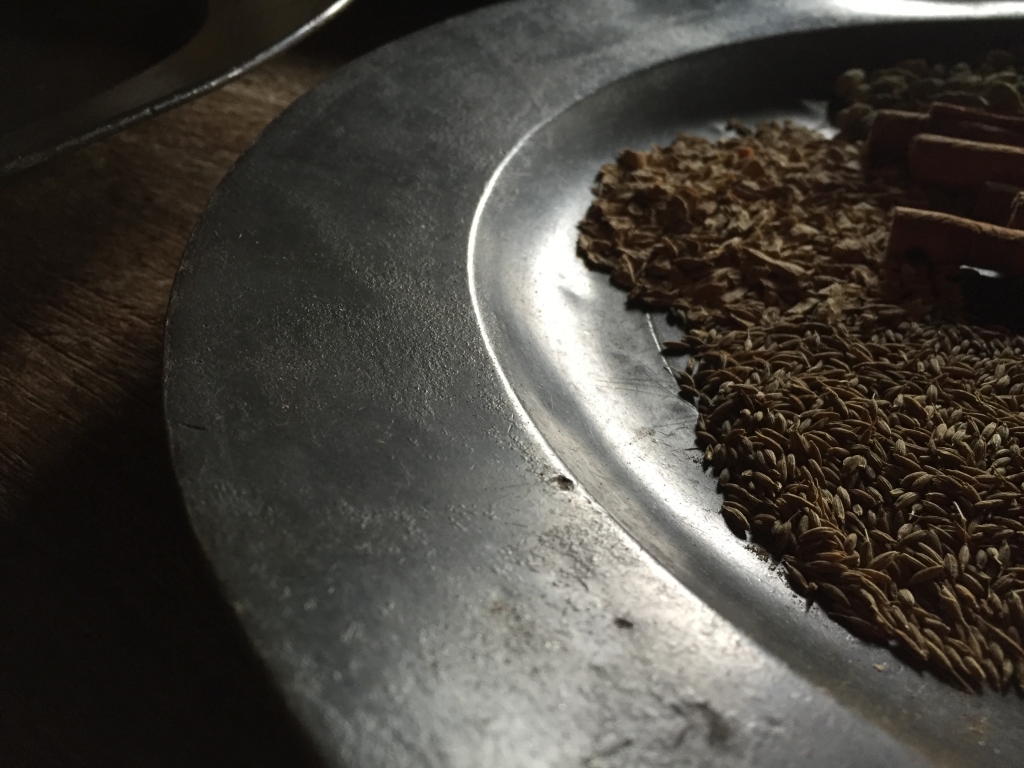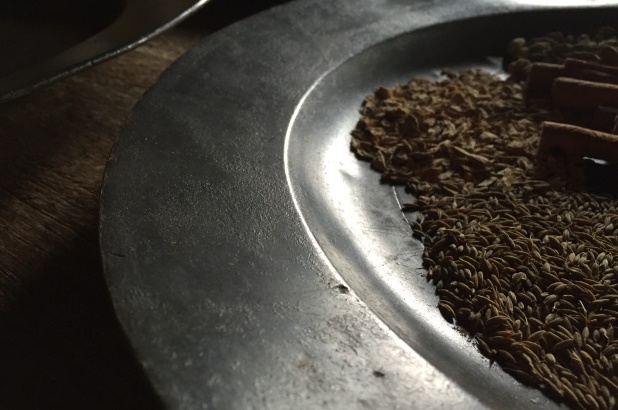Its hard to imagine a 19th century kitchen without its signature metals: black cast iron, gleaming brass and copper, and the soft grey of pewter. Our house museums contain numerous pewter items, such as these large plates on the kitchen table at Elizabeth Farm:

Pewter plates on the kitchen table at Elizabeth Farm. Photo (c) Scott Hill for Sydney Living Museums
At Vaucluse House you can see candlesticks, and a diminishing set of pewter measuring jugs shaped like tankards. But what exactly is pewter?
In use since ancient Rome, pewter is a metal alloy, a combination of tin hardened with copper and other metals such as bismuth, lead (eek!) or (since the 1600s, and most successfully) antimony. It can be cast or hammered into shape, often both, and when damaged – unlike ceramics or glass which shatter when dropped – it could be repaired by tinkers who came door to door. If you really succeeded in mangling it, say by bludgeoning the Professor in the library with a pewter candlestick, pewter ware could be melted down and recast.
It was made into a vast number of household objects: tea sets, caddies, candlesticks, inkwells, cruets, goblets, mugs, jugs, porringers, plates and bowls, ornaments, statuettes, the list goes on. Importantly, pewter wasn’t some second rate metal, decried as ‘poor man’s silver’ for example. It was highly valued in the medieval through to the 19th centuries, and often hallmarked; when it declined in daily use it was only because manufacturing brought down the cost of more expensive silver with the invention of pressure plating and then electroplating.
Remember Hartog’s dinner plate?
One of the most important objects related to the European exploration of Australia is in fact a pewter plate, inscribed and nailed to a post at Shark Bay, West Australia, in 1616 to say “I was here” [1] by Dutch explorer Dirk Hartog (retrieved by another Dutch Captain 80 years later it can be seen today in the Rijksmuseum in Amsterdam). For many years a pewter mug was a traditional gift at a young man’s 21st birthday, and sitting on my own desk is a vintage pewter mug (full of pens) that I was given as a ‘prize’ after a lengthy work project.
While there are numerous advertisements for pewter spoons, dishes and household nick-knacks in early colonial newspapers, this must be one of the most unique for the hiding place for hot pewter:
On Tuesday night last, between the hours of nine and ten, a Robbery was committed in a house at the upper end of Pitt’s Row… A house in the same Row was on Tuesday evening searched on an information, and a stolen watch, together with one of the small pewter pans useful in the Dispensary, found entombed in a large pumpkin; the persons who inhabited the premises were committed to gaol, as the first specimen of approbation of the ingenious contrivance. {The Sydney Gazette, 21st August, 1803}
Sad… so sad…
Like a potter and a pot, those who work in pewter are known as – wait for it – ‘pewterers’, however there are then distinctions depending on what was being manufactured. Flat items such as bowls, plates or large chargers made from pewter are historically known as ‘sadware’, and those who made it were known as ‘sadware-men’. That’s quite a depressing career title to aspire to. Those who made pitchers, jugs and so on were ‘hollow-men’.
I’ve read various (and often highly imaginative) explanations for the term ‘sadware’, none of which are referenced, and suspect it simply comes from an earlier alternate definition of ‘sad’ as meaning ‘dark-coloured’ [for example Johnson’s Dictionary, 1755], so a reference to the dark colour of pewter. If anyone has a better answer please leave a comment [2].
Rule Britannia!
You may also have heard of ‘Britannia metal’. This is a variation of Pewter, with a slightly different composition, defined by the (British-based) Pewter Society as – “a pewter alloy containing a comparatively high proportion of antimony – typically 92% tin, 6% antimony and 2% copper”. The alloy was invented around 1770 in the industrial town of Sheffield and became popular very quickly, not simply for its inexpensive cost, but especially because of the high gleaming polish it could achieve:
BRITANNIA METAL HAS LARGELY SUPERSEDED THE USE OF PEWTER.
The general disuse of the old pewter ware, once so common in this country, has been followed by the introduction of another metal, in the manufacture of which a degree of ingenuity is constantly displayed, to which the ancient pewterers were altogether strangers. The modern material, the base of which is tin, has been called Prince’s metal, more commonly Britannia metal, and by the workmen white metal. It is not only wrought into all the variety of elegant and useful articles to which silver is applied, but, along with its capability of receiving almost every modification of which that precious metal is susceptible, it also very much resembles it in colour and brilliancy. It possesses also, when quite new, and in some articles of a fine quality, candlesticks in particular, an effect which an inexperienced eye might easily, before the metal became common, have mistaken for silver. [3]
It had a down side though: the author continued that “nothing is so common in an ordinary tea-table display, among even the middle classes” as a Britannia ware teapot, and warned that if constructed poorly its lightweight construction left it vulnerable to distortion and sagging after prolonged use with hot water. Which is awkward when that’s what a teapot is, well, for…
Caring for pewter
Yes, pewter can be polished, but to do so destroys the patina of decades if not hundreds of years. At Elizabeth Farm and Vaucluse House we simply clean our pewter-ware with a gentle dust and, if needed, a hand-wash in warm soapy (not hot) water, with a thorough rinse and dry afterwards.

The patina of old pewter. Photo (c) Scott Hill for Sydney Living Museums
You may have noticed the two holes in this plate’s broad rim, and we are asked about them quite often: its the holes from when this plate was once displayed by a past owner, suspended from a cord. Two of our plates have these holes. Old pewter has for many years been a highly desirable decorators item, to the point of being a kitchenalia cliche:
PEWTER.
If you possess any pint measure or mugs made of pewter you will be quite justificd in giving them the place of honor in the living room to catch the reflection of life on cold nights, no matter how battered they are… Neither silver, brass nor copper can rival pewter in simple elegance. There is a great satisfaction in collecting pewter, but collect it with the idea of beautifying your home, and not to make a miniature museum. Its chief charm lies in its color— a modest silvery sheen—and so it must be placed where plenty of light will fall, for old pewter is a delicate thing, and will take on a dull leaden hue in dim surroundings. [The Age (Melbourne), 5th July 1927.]
References
1.The plate reads “1616. On the 25th October the ship Eendracht of Amsterdam arrived here. Upper merchant Gilles Miebais of Luick (Liege); skipper Dirck Hatichs (Dirk Hartog) of Amsterdam. On the 27th ditto we sail for Bantum. Under merchant Jan Stins; upper steerman Pieter Doores of Bil (Brielle). In the year 1616.“. Source: Migration Heritage Centre entry on the Hartog plate.
2. A heavy, solid iron, usually with a detachable handle and that was heated on a stove top for use is known as a ‘sad-iron’. I’ve come across several discussions that say ‘sad’ was an old/archaic term for ‘solid’ or ‘heavy’ – except the definitions I’ve seen in early dictionaries that give this definition of ‘sad’ connect it to ‘heavy’ in its emotional sense (sad, depressed etc), not as a reflection of weight. Pewter inst nearly as heavy as iron or ceramics of similar size, so again it makes little sense as a source of the name. Again, if you know more Id love to hear from you!
3. Rev. Dionysius Lardner, et al. The cabinet cyclopaedia: a treatise on the progressive improvement and present state of the manufactures in metal. Vol. III. Tin, lead, copper, brass, gold, silver, and various alloys. London: Longman, Rees, Orme, Brown, Green, & Longman, and John Taylor. 1834
The website of the British Pewter Society is a great source of information.



